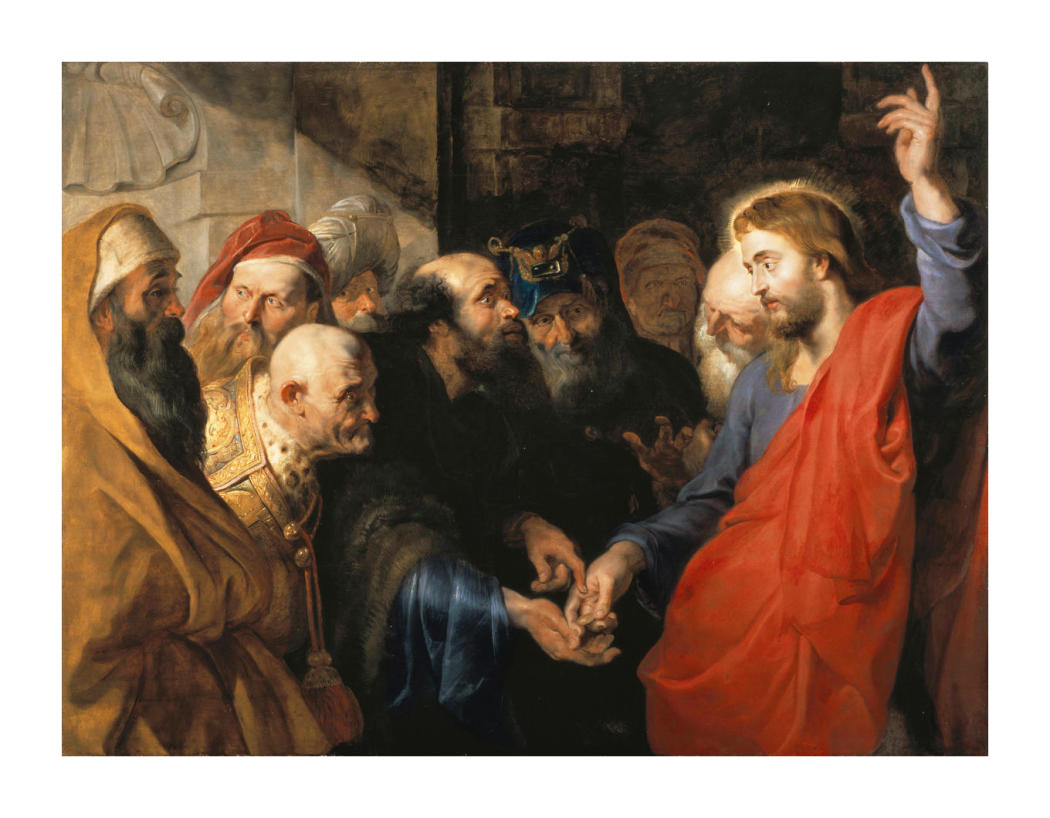The Tribute Money, Rubens
Mount Calvary Church
A Roman Catholic Parish
The Personal Ordinariate of S. Peter
Eutaw Street and Madison Avenue
Baltimore, Maryland
Rev. Albert Scharbach, Pastor
Andrew Johnson, Organist and Music Director
Trinity XIX
October 18, 2020
8:00 A.M. Said Mass
10:00 A.M. Sung Mass
This mass will be livestreamed.
Lunch outside after 10 AM Mass, weather permitting.
___________________
Organ Prelude
Herr Gott, dich loben alle wir (Lord God, we all praise You), Johann Pachelbel (1653-1706)
Johann Pachelbel represents the pinnacle of organ music in 17th-century Southern Germany. A generation before Bach, Pachelbel used chorale tunes as the basis for many of his compositions. This chorale prelude uses the tune OLD HUNDREDTH, played by the pedals below imitative counterpoint in the manuals.
__________
Organ Postlude
Processional in D minor, Robert Lind (b. 1940),
Lind succeeded his mentor, Leo Sowerby, as Organist and Choirmaster at the Cathedral of St. James from 1962-1965. Lind has written extensively for the organ while serving various other churches in the Chicago area. This postlude begins with a stately march, followed by a more lyrical contrasting section and a grand recapitulation.
___________________
Offertory Anthem
The Lord’s Prayer, John Sheppard (1515-1558)
Our Father which art in heaven,
Hallowed be thy name,
Thy kingdom come, Thy will be done
In earth as it is in heaven.
Give us this day our daily bread,
And forgive us our trespasses
As we forgive them that trespass against us,
And let us not be led into temptation,
But deliver us from evil.
For Thine is the kingdom and the power,
To Thee be all honor and glory forevermore.
Always so be it.
John Sheppard was an English composer of the early 16th century. This anthem is set largely in imitation with the contour of each melody often reflecting the meaning of the text. For example, “Thy will be done in earth” falls down the scale as if descending from heaven, while the text “as it is in heaven” ascends back up the scale.
_________
Communion Anthem
Ave verum corpus, William Byrd (1543-1623)
Ave verum corpus,
Natum de Maria virgine;
Vere passum immolatum
In crucis pro homine.
Cuius latus perforatum
Unda fluxit sanguine.
Esto nobis praegustatum
In mortis examine.
O dulcis, o pie,
O Jesu Fili Mariae,
Miserere mei. Amen.
Hail, true body,
Born of the virgin Mary;
Who has truly suffered, slaughtered
On the Cross for humanity.
Whose side was pierced,
Pouring out water and blood.
Be a foretaste for us
During our ordeal of death.
O sweet, o holy,
O Jesus Son of Mary,
Have mercy on me. Amen.
William Byrd was a prolific Roman Catholic composer during the musical Renaissance. The composer uses homophony to promote the intelligibility of this sacred text, saving imitation for the final section: a dramatic, repetitive plea for God’s mercy.
___________________
Hymns
Jesus shall reign is by Isaac Watts (1674–1758), who interprets Psalm 72 using a Christological lens. The king referenced in the psalm is Christ, and could be no one else. For Watts, as for the Fathers of the Church, the Old Testament makes sense in light of the New, and vice versa. The tune DUKE STREET was composed by John Warrington Hatton (1710-1793), who supposedly lived on Duke Street in Lancashire, from where his famous tune name comes.
Jesus calls us o’er the tumult is by Cecil Frances Alexander (1818-1895). It contains a revivalist note which was also part of the Oxford Movement, which emphasized the Catholic nature of the Church of England in order to call men to conversion and a holy life. This is a hymn of unmistakable challenge – in its opening three words and its imperatives (‘Christian, love me’, ‘make us hear’). The tune RESTORATION was first printed in William Walker’s Southern Harmony (1835).
Sing praise to God, who reigns above is a translation by Frances Elizabeth Cox (1812—1897) of Sei Lob und Ehr’ dem höchsten Gut by Johann Jacob Schütz (1640-1690). He became a Pietist, and the hymn has the warm, affectionate tone of German Pietism. Using a variety of metaphors for God and for His works, this text overflows with proclamations of God’s loving care for His people. This hymn extols the greatness of God in giving all good things to His people and calls on us to continue to give God the praise He richly deserves. The tune, MIT FREUDEN ZART, is beloved of the American Moravians. The tune name itself – “with tender joy” – expresses something of the character of the life and music of the Moravians.
